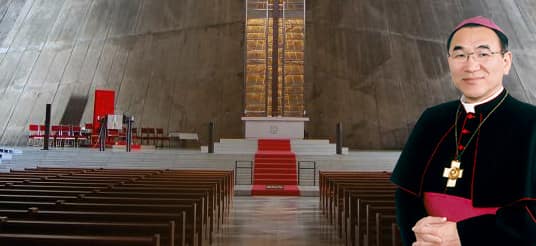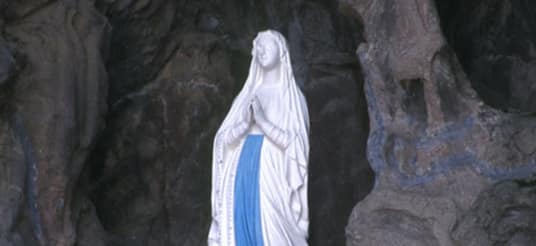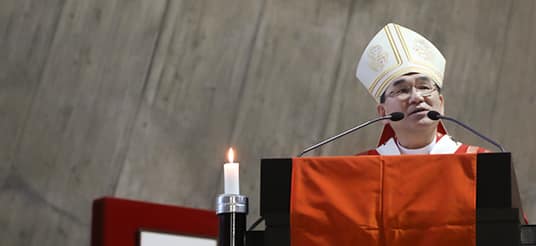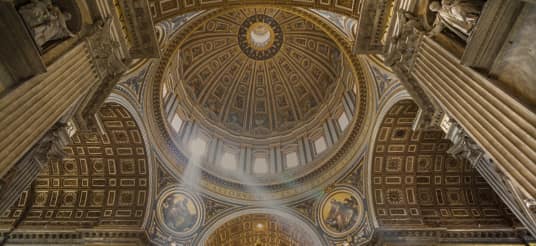Archdiocese of Tokyo

On Entering the”Year of Faith”
(Letter from Archbishop Okada)
Sep 30, 2012
To all Catholics of the Archdiocese of Tokyo,
May the peace of the Lord be with you all!
Pope Benedict XVI, in order to commemorate the 50th anniversary of the Second Vatican Council and the 20th anniversary of the promulgation of the Catechism of the Catholic Church, has proclaimed a “Year of Faith” starting from October 11, 2012, and lasting until November 24, 2013. (1)
As we approach the “Year of Faith,” I have on many occasions appealed to all in the Archdiocese of Tokyo to confirm their faith, deepen it, bear testimony to it, and transmit it in their surroundings. Today once again, bearing in mind the priorities of the Archdiocese (2), I would like to ask all of you to make a renewed effort with regard to the following matters.
1. To know Jesus Christ more deeply.
The most important aim of this Year of Faith is to come to a deeper knowledge of the Lord Jesus Christ, the “pioneer and perfecter of our faith” (Heb 12:2), “the Way, the Truth, and the Life” (John 14:6). (Porta Fidei 13)
Jesus is the supreme leader of our faith. By his death on the cross Jesus of Nazareth fulfilled his faith in God the Father. Jesus’ life delineated in the Gospels has fully revealed the “model of faith that has characterized the history of our salvation over a span of two thousand years” (Porta Fidei 13). Let’s learn how to deepen our faith through the words and life of Jesus Christ.
It goes without saying that what is most important in order to learn from the words and life of Jesus Christ is to study and relish the four Gospels. The Gospels are always read at Mass, so please study and appreciate the gospel of each Sunday’s Mass. The homily interprets the Gospel which has been read, connects it with our daily life and contemporary society, and encourages believers to live every day according to their faith.
The Sunday Mass also has two additional readings. The first reading in many cases is taken from the Old Testament. The Old Testament describes the history of salvation before Jesus Christ and points in advance to the coming of the Savior. The second reading is from the letters of the Apostle Paul or others, and shows how the primitive church understood the words and life of Jesus Christ. Becoming familiar with the content of these two readings also helps us acquire a better understanding of the day’s Gospel.
2. To study the Second Vatican Council and the Catechism of the Catholic Church.
Let’s study the teachings of the Second Vatican Council, which now marks its 50th anniversary. First, consider why the Council was summoned and the intent and purpose of that great meeting of all the bishops of the world. Try to understand also how the Second Vatican Council reformed the Church. I earnestly desire that in each parish, each religious house, as well as in various groups, opportunities should be provided to learn about the Second Vatican Council. (3)
The Catechism of the Catholic Church is a new compilation based on the teachings of the Second Vatican Council. It was issued exactly twenty years ago. It will be very beneficial to learn about the authoritative teachings of the Catholic Church as renewed by the Council. As a text, you can also use the Compendium of the Catechism of the Catholic Church. You can also consider reading especially those parts that have been reformed by the Council. I truly recommend the study of the Catechism. (4)
3. To study the Creed.
I recommend that we also re-study the meaning of the Creed that we always recite during the Mass on Sundays and Feasts of Obligation.
The Creed is a “Profession of Faith” which briefly summarizes the common understanding of the faith established by the ancient Church. It is the heritage of our faith that we continue to recite as a prayer.
The Creed begins with the words “I believe” (Credo) and is recited during Mass as a declaration of the faith of the community. For over two thousand years the Church has recited this common profession of community faith. When we recite the Creed, we assert what we believe, whom we believe in, and how we believe. The proclamation of the Creed has the effect of deepening our faith. The explanation of the Creed given in the Catechism of the Catholic Church leads us to a deeper understanding and appreciation of the faith of the ancient Church.
How to express the understanding of the faith of the ancient Church and how to transmit it in modern Japan are important challenges. I hope that we may all continue to study and do research in this matter.
4. Liturgy and Sacraments / daily prayer and meditation.
The Church was born on the day of Pentecost. It is a gathering of human beings who, though weak, are constantly supported and guided by the Holy Spirit, who expresses and conveys the work of Christ’s salvation. Even now, everywhere throughout the world, Christ is spiritually at work through the liturgy and the sacraments of Baptism, Confirmation, the Eucharist, Penance, the Anointing of the Sick, Holy Orders, and Matrimony.
In addition to giving importance to the grace of the sacraments, let us pray that many people in Japanese society may share the grace of the sacraments of initiation (Baptism, Confirmation, and the Eucharist) and let everyone of us therefore offer all the services we are capable of. (5)
Regarding daily prayers, before the Second Vatican Council there was a prayer book entitled Prayers of the Catholic Church for all Japan, and the Angelus was daily recited by the faithful. Currently, the Liturgy of the Hours (breviary) is also recommended for the daily prayer of the laity. There are also various prayer books issued to help people pray. Let us encourage one another to spend some time every day cherishing prayer and receiving New Life by reading the Word of God. On this occasion, I highly recommend that you continue to read the Old and New Testament.
For retreats to be held in Advent and Lent, I would propose taking “faith” as the main theme during this “Year of Faith.” It will be an opportunity to reflect on our own faith as well as to deepen it.
5. Witness of faith and love.
The “Year of Faith” is a good opportunity to deepen our faith and to practice Christian Love. (Porta Fidei 14) “So faith, hope, love remain, these three; but the greatest of these is love” (I Corinthians 13: 13).
Jesus said. “Whatever you did for one of these least brothers of mine, you did for me” (Matthew 25: 40). This is an important message to be received with deep faith. So many people, no matter how greatly deprived of human dignity, are seeking understanding and solidarity, liberation and salvation, and desire to be truly cared for as human beings. Again, it is not unusual to find people suffering from deep loneliness and loss of purpose who cannot understand who they are and what life is for. The fact that in modern Japan the number of suicides is extremely high is a problem that should be etched deeply in our minds as disciples of Christ. Amid these harsh modern realities, putting into practice the love of God that accepts and recognizes every person as irreplaceable will be an important witness in transmitting faith to people. This testimony of God’s love is the very work of evangelization.
I think it is an important duty of the faith community to look at the reality of our society and our world while studying the social doctrines of the Church and to strive with courage and wisdom to overcome the problems of humanity.
Our life is a journey of faith, a pilgrimage. (6) Thankful that “we have passed already from death to eternal life” (John 5:24, I John 3:14), and remembering those who have left this world, we are guided every day by the Holy Spirit. I pray through the intercession of the Holy Virgin Mary that we ourselves may participate in the completion of the Passover from death to life.
May the abundant blessings of God, the Father, the Son, and the Holy Spirit be upon you always.
September 30, 2012
Peter Takeo Okada
Archbishop of Tokyo
Postscript
The Archdiocese of Tokyo will offer a Mass to begin the “Year of Faith” on October 14 (28th Sunday of the year) at 10:00 at Sekiguchi Cathedral Church of Tokyo, with the Archbishop as the main celebrant.
Please read also the document of the Bishops which is scheduled for publication on October 5, during the extraordinary general meeting of the Bishops. It describes the history of the evangelization of the Catholic Church in Japan after the Second Vatican Council.
Notes:
(1) The spirit of the “Year of Faith” is described in Pope Benedict XVI’s Apostolic Letter Motu Proprio entitled Porta Fidei (The Door of Faith). (Published by the Catholic Bishops’ Conference of Japan).
(2) For the three priorities, see for example the New Year’s Mass sermon of January 10, 2010. “Ongoing faith formation, Spiritual growth (promotion of evangelization by the laity),” “Growth as a multinational church (Pastoral care for foreigners),” ”Mental problems and Mental support (Supporting people who suffer from spiritual and mental ailments).”
(3) The revised translation of the documents of the Second Vatican Council is scheduled for publication next spring. It consists of 16 texts (four Constitutions, three Declarations, and nine Decrees). I recommend that you study the contents by reading the commentaries. I especially recommend that you also read the text itself of Lumen Gentium, (Constitution on the Church) and Gaudium et Spes (Constitution on the Church in the Modern World).
(4) Four types of Catechism books are available, all published by the Catholic Bishops’ Conference of Japan.
Catechism of the Catholic Church
Compendium of the Catechism of the Catholic Church
The Teaching of the Catholic Church. Considering the Japanese situation and culture, the Catholic Bishops’ Conference published this new book compiled on the basis of the Catechism of the Catholic Church.
YOUCAT. The Japanese Bishops’ youth department is translating and plans to publish in June next year a new book for youth.
(5) You can also learn about the sacraments from the four types of Catechisms listed above.
(6) During the “Year of Faith,” pilgrimages to various holy places (Sanctuaries which commemorate the Lord Christ, the Virgin Mary, the saints and the martyrs) as a journey to deepen the faith are highly recommended.





